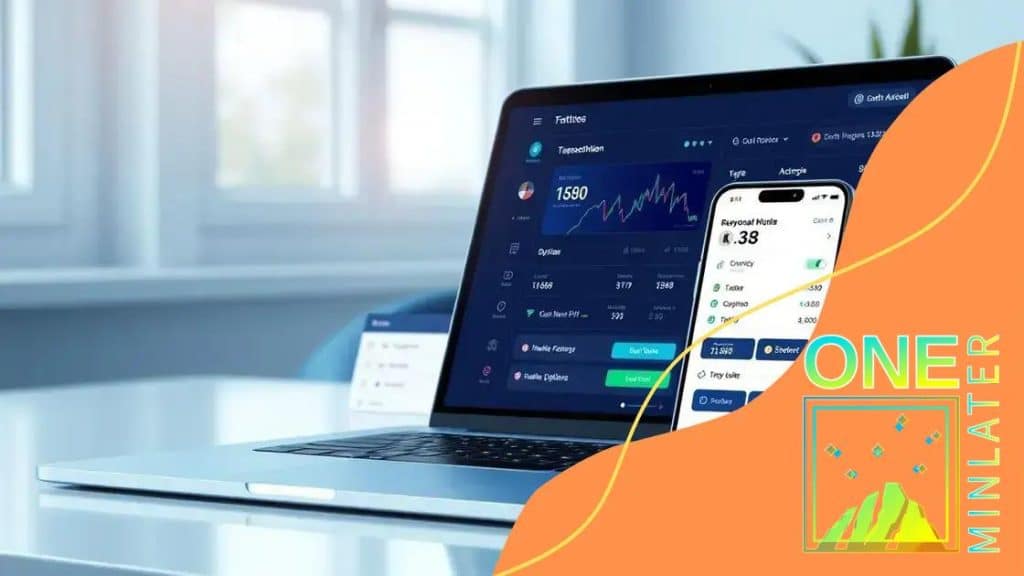Understanding decentralized finance (DeFi) applications

Understanding decentralized finance (DeFi) applications allows users to access financial services directly on blockchain platforms, eliminating intermediaries and offering benefits like lower costs, increased accessibility, and innovative financial products while also posing inherent risks.
Understanding decentralized finance (DeFi) applications might sound complex, but it opens up a world of innovative financial services. These applications could change how we manage money and interact with traditional banking. Curious how they might impact your finances?
What is decentralized finance (DeFi)?
Decentralized finance (DeFi) refers to a new financial ecosystem that eliminates intermediaries, such as banks, by using blockchain technology. This means anyone can access financial services directly from their devices. DeFi is built on platforms that are secure and transparent, allowing users to trade, lend, and earn interest on their assets.
The core features of DeFi
DeFi offers unique benefits that make it appealing to many users. Here are some core features you should be aware of:
- Access to global markets: Users from anywhere in the world can participate.
- Lower fees: Since there are no intermediaries, transaction costs are typically lower.
- Transparency: All transactions are recorded on the blockchain, providing a clear audit trail.
- Innovation: New financial products and services are continually being developed in this space.
The power of DeFi lies in its ability to provide more control to individuals. Users can manage their assets without needing to rely on traditional finance systems. This not only empowers individuals but also encourages financial inclusion.
Furthermore, with DeFi, savings accounts and other financial products are often more lucrative than traditional banks offer. This creates an opportunity for people to grow their wealth more effectively.
How does DeFi work?
DeFi operates on smart contracts, which are self-executing contracts with the terms directly written into code. These smart contracts facilitate, verify, or enforce the negotiation and performance of financial contracts, allowing transactions to happen automatically.
To participate in DeFi, you usually need cryptocurrencies with which you can interact on various platforms. By connecting your digital wallet, you can access lending protocols, exchanges, and more, all without traditional banks being involved.
Key components of DeFi applications
Key components of DeFi applications are vital for understanding how these platforms operate. Each element plays a crucial role in creating a seamless experience for users looking to engage in decentralized finance.
Smart Contracts
At the heart of every DeFi application is the smart contract. These are self-executing contracts with the terms of the agreement directly written into code. This technology removes the need for intermediaries and automates processes, allowing instant execution of trades and transactions.
Decentralized Exchanges (DEXs)
Decentralized exchanges enable users to trade cryptocurrencies directly with one another, eliminating the need for a central authority. This process enhances privacy and security, making DEXs popular among DeFi enthusiasts.
- Liquidity Pools: Users can provide their assets to these pools to facilitate trading, earning fees in return.
- Lower Fees: Trades usually incur lower fees compared to traditional exchanges.
- Access to diverse tokens: Users can trade various cryptocurrencies that may not be available on conventional exchanges.
This framework allows for a broad spectrum of trading options, accommodating different preferences and strategies.
Lending Platforms
Lending platforms in DeFi offer users the ability to borrow and lend cryptocurrencies without traditional banks. These platforms utilize smart contracts to automate lending processes.
When users lend their assets, they can earn interest. Conversely, borrowers can obtain funds without lengthy approval processes. This provides an efficient way for users to leverage their assets.
Overall, understanding these key components is crucial for anyone looking to navigate the world of DeFi. Each element interacts and enhances the overall ecosystem, providing users with unique opportunities and experiences.
Advantages of using DeFi applications

There are many advantages of using DeFi applications that attract users seeking more than traditional banking services. These benefits make DeFi an exciting option in the financial landscape.
Greater Accessibility
DeFi applications provide access to financial resources for anyone with an internet connection. This significantly allows individuals in underserved regions to participate in global finance. Unlike banks, which often require extensive documentation and approval, DeFi platforms typically require just a digital wallet.
Lower Costs
Transactions using DeFi applications often incur lower fees compared to traditional finance. This can be especially beneficial when dealing with large sums of money.
- No intermediaries: Since there are no middlemen, users save on costs associated with banks and brokers.
- Flexible transactions: Users can conduct trades and transactions without hefty fees.
- Less likelihood of hidden costs: Everything is transparent and visible on the blockchain.
Such features enhance the overall value provided by DeFi platforms.
Potential for Higher Returns
DeFi applications offer opportunities for higher returns on investments compared to traditional savings accounts. Users can lend their assets and earn interest rates that often exceed those offered by banks. This is particularly appealing for those looking to grow their wealth over time.
Additionally, providing liquidity to exchanges can also yield rewards, allowing users to earn passive income. Many DeFi platforms have token incentives that further sweeten the deal.
Transparency and Security
All transactions in the DeFi ecosystem are recorded on the blockchain, providing full transparency. Users can trust that their assets are handled securely. Moreover, with the decentralized nature of these applications, there is a reduced risk of single points of failure or fraud.
Overall, the advantages of using DeFi applications present both flexibility and innovation, making them an appealing alternative to traditional finance. Users can enjoy a borderless financial system that empowers them directly.
Risks associated with DeFi
While DeFi offers many benefits, it also comes with certain risks associated with DeFi applications that users should be aware of. Recognizing these risks is crucial for anyone looking to engage in this space.
Smart Contract Vulnerabilities
One of the primary risks lies in smart contract vulnerabilities. These contracts operate on code, which can contain bugs or loopholes. If exploited, these vulnerabilities can lead to significant financial losses. Regular audits are necessary to identify and fix such issues, but not all DeFi projects prioritize this.
Lack of Regulation
DeFi operates outside traditional financial systems and regulations. While this provides freedom, it also means that users lack protection. In cases of fraud or failure, recourse options may be limited or nonexistent. People using DeFi applications should understand that there is no central authority to provide security.
- Market volatility: Cryptocurrencies can experience extreme price fluctuations.
- Liquidity risks: Some platforms may have low liquidity, making it hard to execute trades.
- Impermanent loss: Users providing liquidity can lose money if market prices change significantly.
These factors can heighten the inherent risks when dealing with DeFi applications.
Security Threats
Another area of concern involves security threats such as hacking. DeFi platforms have been targets for cybercriminals. Successful hacks can lead to the theft of funds and can impact multiple users. Users need to implement security measures like using secure wallets and enabling two-factor authentication.
By being informed about the potential risks associated with DeFi, users can make wiser decisions and take necessary precautions while navigating this innovative yet complex financial landscape.
The future of decentralized finance
The future of decentralized finance (DeFi) looks promising and full of potential. As more people become aware of the advantages of DeFi, its adoption continues to grow. This expansion leads to innovation and new financial services that can benefit a wider audience.
Increased Adoption
As technology progresses, more individuals and businesses may choose to engage with DeFi applications. Increased adoption will make it easier for users to access decentralized financial services. This could lead to a significant shift away from traditional banking systems.
Integration with Traditional Finance
We might see a trend where DeFi starts to integrate with traditional financial institutions. Such integration can offer a hybrid solution that combines the best of both worlds. Banks may begin to offer DeFi products, providing customers with more options and features.
- Better accessibility: More users will find it easier to engage with DeFi due to improved interfaces.
- Partnerships: DeFi platforms may partner with traditional banks to enhance their services.
- Regulatory clarity: Regulations could help mitigate risks and provide a safer environment for users.
This kind of collaboration could lead to a very dynamic financial landscape.
Innovative Financial Products
The DeFi space is known for innovation, and this will likely continue. New financial products will emerge, such as insurance solutions, detailed analytics, or investment tools tailored for everyday users. This innovation can help make managing finances more accessible and engaging.
As the sector matures, user-friendly interfaces will be developed, making it easier for anyone to navigate these tools. Education and awareness will also play an important role in how users interact with DeFi applications.
Challenges to Overcome
Despite its bright future, DeFi still faces challenges. Issues like security risks, regulatory concerns, and market volatility need to be addressed. As the community works to solve these problems, users can expect improvements that will help stabilize the industry.
Through innovation, collaboration, and education, the future of decentralized finance promises to reshape how we view and interact with money.
FAQ – Frequently Asked Questions about Decentralized Finance (DeFi)
What is decentralized finance (DeFi)?
DeFi refers to a financial system built on blockchain technology that allows for peer-to-peer financial services without intermediaries, such as banks.
What are the advantages of using DeFi applications?
DeFi applications offer benefits like lower transaction costs, greater accessibility, and the potential for higher returns on investments.
What risks should I be aware of when using DeFi?
Risks include smart contract vulnerabilities, lack of regulation, and security threats like hacking, which can lead to financial losses.
How is the future of DeFi expected to evolve?
The future of DeFi looks promising with increased adoption, innovation in financial products, and potential integration with traditional finance, although challenges remain.





